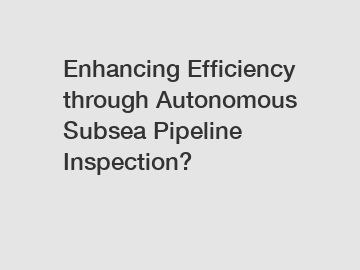Enhancing Efficiency through Autonomous Subsea Pipeline Inspection?
Enhancing Efficiency through Autonomous Subsea Pipeline Inspection?
Autonomous subsea pipeline inspection has emerged as a promising technology that enhances efficiency in the oil and gas industry. By utilizing autonomous underwater vehicles (AUVs) equipped with advanced sensors and imaging systems, companies can now conduct thorough inspections of subsea pipelines without the need for human divers or remotely operated vehicles (ROVs). This technological leap forward has revolutionized the way pipeline inspections are carried out, offering faster, more accurate, and cost-effective solutions for maintaining the integrity and safety of subsea infrastructure.
The traditional method of inspecting subsea pipelines involved deploying human divers or ROVs to manually inspect the pipelines, a process that is not only time-consuming and labor-intensive but also poses significant safety risks. In contrast, autonomous subsea pipeline inspection eliminates the need for human intervention, reducing the time and resources required to complete inspections while minimizing the risks associated with diving operations. By deploying AUVs equipped with sophisticated sensors and imaging systems, companies can now conduct inspections with greater accuracy and efficiency, ensuring the timely detection of potential defects or anomalies in the pipeline.

The benefits of autonomous subsea pipeline inspection are manifold. Firstly, it allows companies to conduct inspections more frequently and with greater precision, leading to early detection of potential issues and proactive maintenance measures. This minimizes the risk of costly and dangerous pipeline failures, enhancing overall safety and environmental protection. Moreover, autonomous inspection technologies can cover larger areas in a shorter amount of time, providing a more comprehensive overview of the condition of subsea infrastructure.
The adoption of autonomous subsea pipeline inspection also has positive economic implications for companies operating in the oil and gas industry. By reducing the time and resources required for inspections, companies can lower operational costs and increase operational efficiency. This not only improves the bottom line but also allows companies to redirect resources towards other critical aspects of operations, such as asset maintenance and management. Overall, autonomous subsea pipeline inspection represents a significant step towards enhancing efficiency, safety, and sustainability in the oil and gas industry.
In conclusion, autonomous subsea pipeline inspection offers a multitude of benefits for companies operating in the oil and gas industry. By leveraging advanced technologies such as AUVs equipped with specialized sensors, companies can conduct faster, more accurate, and cost-effective inspections of subsea pipelines. This not only enhances operational efficiency and safety but also contributes to the overall sustainability of subsea infrastructure. As the industry continues to embrace autonomous technologies, we can expect to see further advancements in subsea pipeline inspection, ultimately leading to a more reliable and resilient energy infrastructure.
If you are looking for more details, kindly visit Hydrotesting of Pipeline, Flange Management Service China supplier, N2 Leak Test.

Comments